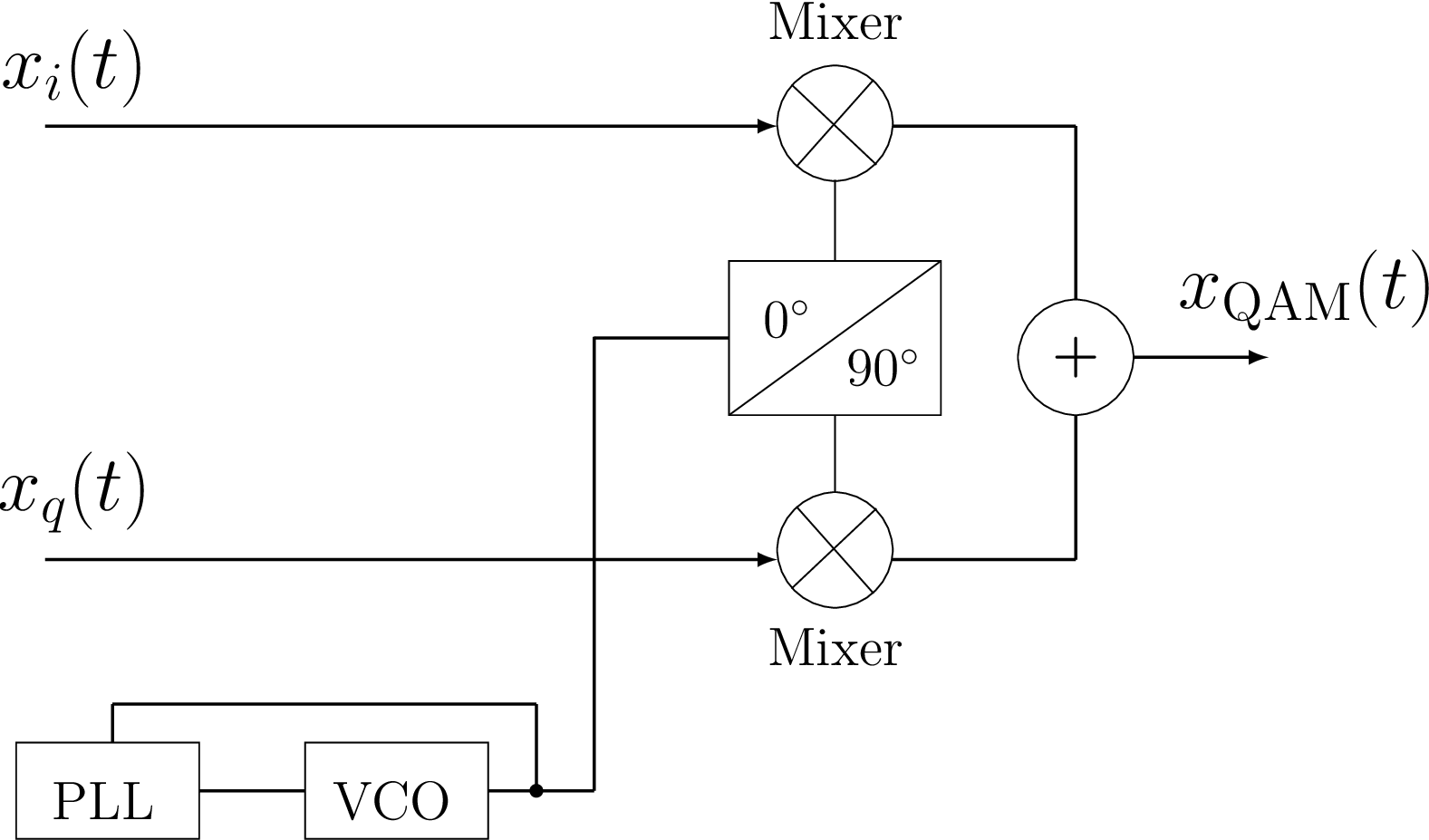3.3 QAM Represented with Real-Valued Signals
The QAM signal is obtained by simultaneously using a cosine of frequency to upconvert a PAM and a sine of the same frequency to upconvert another PAM. In spite of these two passband PAM being superimposed (overlapping) in frequency, they can be individually recovered at the receiver. The details of QAM generation are described in the sequel.
Using the same method of PAM generation from a single bitstream, one can create two PAM signals by splitting the original bitstream with rate into two, with rate each. Assuming continuous-time signals, these bitstreams are represented by PAM signals and , which are then multiplied by a cosine and sine, respectively, to create the QAM signal
|
| (3.2) |
Assuming the cosine as a reference, the sine is obtained by delaying it of 90 degrees, i. e., using the fact that . Hence, and are called the in-phase (I) and quadrature (Q) components of a QAM signal, respectively. Figure 3.3 illustrates a possible QAM generation procedure.

Trigonometry gives a hint on how the two PAM signals that compose a QAM signal can be recovered at the receiver. Multiplying of Eq. (3.6) by and filtering, allows to recover , while multiplying by and filtering, allows to recover . The multiplication creates a version of the desired PAM component at DC (downconverts it back to baseband) and two signals at twice the carrier frequency, as follows (see Eq. (A.7) and Eq. (A.5)):
such that a lowpass filter can approximately eliminate the signals at frequency rad/s and recover . A similar trick can be used to recover .
Linear algebra can complement the intuition provided by trigonometry in Eq. (3.3). Recall from Example D.2 that a cosine and sine of the same frequency are orthogonal. Similar to Eq. (2.32), one can eliminate via the inner product:
This result is not of practical use as it is due to the infinite-duration interval, but indicates the importance of orthogonality for modulation.
Figure 3.4 depicts a scheme for QAM demodulation using only real-valued signals. In practice, one cannot use ideal filters, but the attenuation of the signals at rad/s can be controlled by the order of these filters.

Listing 3.2 illustrates how to create and recover the QAM symbols using the scheme suggested by Figure 3.3 and Figure 3.4, respectively.
1%% QAM modulation and demodulation using only real-valued signals 2%% Transmitter: generate QAM signal centered at Fs/4 Hz (pi/2 rad) 3M=16; %number of symbols, modulation order 4constellation=ak_qamSquareConstellation(M); %QAM constellation 5S=1000; %total number of symbols to be simulated 6symbolIndicesTx=floor(M*rand(1,S)); %indices at transmitter 7symbolsTx=constellation(symbolIndicesTx+1); %random symbols sequence 8sym_i=real(symbolsTx); sym_q=imag(symbolsTx); %extract real/imag 9L=8; %oversampling factor 10xi=zeros(1,S*L); xq=zeros(1,S*L); %pre-allocate space 11xi(1:L:end)=sym_i; xq(1:L:end)=sym_q; %complete upsampling operation 12p=ones(1,L); %NRZ square wave shaping pulse (there are better pulses) 13xi=conv(p,xi); xq=conv(p,xq); %convolve upsampled with shaping pulse 14%frequency upconvert by carrier at pi/2 rad that corresponds to Fs/4 15n=0:length(xi)-1; %"time" index 16s = xi.*(2*cos(pi/2*n)) + xq.*(2*sin(pi/2*n)); %generate QAM signal 17%% Channel: 18r = s; %ideal channel: no noise, unlimited band 19%% Receiver (runs the demodulation): 20ri = r .* cos(pi/2*n); %start recovering in-phase component 21rq = r .* sin(pi/2*n); %start recovering quadrature component 22b=fir1(length(p)-1,0.5); %FIR with same order of the shaping filter 23 %and use a cutoff frequency of pi/2 rad 24ri = conv(b,ri); %filter the two components to eliminate... 25rq = conv(b,rq); %the terms at twice the carrier frequency 26%skip the transient due to the filters, otherwise it ... 27%shows spurious symbol at (0,0) due to filter's transients 28firstSample=floor(length(p)/2)+floor(length(b)/2)+1; %first sample 29lastSample=firstSample+L*S-1; %last sample to obtain S symbols 30yi=ri(firstSample:L:lastSample); %extract S symbols at baud rate 31yq=rq(firstSample:L:lastSample); %extract S symbols at baud rate 32symbolsRx=yi + 1j*yq; %recompose complex-valued symbols (at baseband) 33plot(real(symbolsRx),imag(symbolsRx),'x'); %plot constellation at Rx 34symbolIndicesRx=ak_qamdemod(symbolsRx,M); %QAM decoding 35SER=ak_calculateSymbolErrorRate(symbolIndicesRx,symbolIndicesTx)
QAM modulation and demodulation using complex-valued signals are discussed in the next sections.